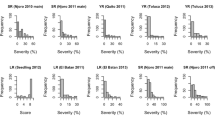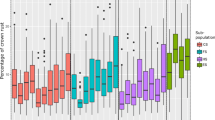Abstract
Key message
We have demonstrated that genomic selection in diverse wheat landraces for resistance to leaf, stem and strip rust is possible, as genomic breeding values were moderately accurate. Markers with large effects in the Bayesian analysis confirmed many known genes, while also discovering many previously uncharacterised genome regions associated with rust scores.
Abstract
Genomic selection, where selection decisions are based on genomic estimated breeding values (GEBVs) derived from genome-wide DNA markers, could accelerate genetic progress in plant breeding. In this study, we assessed the accuracy of GEBVs for rust resistance in 206 hexaploid wheat (Triticum aestivum) landraces from the Watkins collection of phenotypically diverse wheat genotypes from 32 countries. The landraces were genotyped for 5,568 SNPs using an Illumina iSelect 9 K bead chip assay and phenotyped for field-based leaf rust (Lr), stem rust (Sr) and stripe rust (Yr) responses across multiple years. Genomic Best Linear Unbiased Prediction (GBLUP) and a Bayesian Regression method (BayesR) were used to predict GEBVs. Based on fivefold cross-validation, the accuracy of genomic prediction averaged across years was 0.35, 0.27 and 0.44 for Lr, Sr and Yr using GBLUP and 0.33, 0.38 and 0.30 for Lr, Sr and Yr using BayesR, respectively. Inclusion of PCR-predicted genotypes for known rust resistance genes increased accuracy more substantially when the marker was diagnostic (Lr34/Sr57/Yr18) for the presence-absence of the gene rather than just linked (Sr2). Investigation of the impact of genetic relatedness between validation and reference lines on accuracy of genomic prediction showed that accuracy will be higher when each validation line had at least one close relationship to the reference lines. Overall, the prediction accuracies achieved in this study are encouraging, and confirm the feasibility of genomic selection in wheat. In several instances, estimated marker effects were confirmed by published literature and results of mapping experiments using Watkins accessions.




Similar content being viewed by others
References
Bariana HS, Brown GN, Bansal UK, Miah H, Standen GE, Lu M (2007) Breeding triple rust resistant wheat cultivars for Australia using conventional and marker-assisted selection technologies. Aust J Agric Res 58:576–587
Bernardo R (2010) Genomewide selection with minimal crossing in self-pollinated crops. Crop Sci 50:624–627
Cavanagh CR, Chao S, Wang S, Huang BE, Stephen S, Kiani S, Forrest K, Saintenac C, Brown-Guedira GL, Akhunova A, See D, Bai G, Pumphrey M, Tomar L, Wong D, Kong S, Reynolds M, da Silva ML, Bockelman H, Talbert L, Anderson JA, Dreisigacker S, Baenziger S, Carter A, Korzun V, Morrell PL, Dubcovsky J, Morell MK, Sorrells ME, Hayden MJ, Akhunov E (2013) Genome-wide comparative diversity uncovers multiple targets of selection for improvement in hexaploid wheat landraces and cultivars. Proc Natl Acad Sci 110(20):8057–8062
Clark SA, Hickey JM, Daetwyler HD, Van der Werf JHJ (2012) The importance of information on relatives for the prediction of genomic breeding values and implications for the makeup of reference populations in livestock breeding schemes. Genet Sel Evol 44:4
Crossa J, Gdl Campos, Perez P, Gianola D, Burgueno J, Araus JL, Makumbi D, Singh RP, Dreisigacker S, Yan J, Arief V, Banziger M, Braun H-J (2010) Prediction of genetic values of quantitative traits in plant breeding using pedigree and molecular markers. Genetics 186:713–724
Daetwyler HD (2009) Genome-wide evaluation of populations. Wageningen University, Wageningen
Daetwyler HD, Villanueva B, Woolliams JA (2008) Accuracy of predicting the genetic risk of disease using a genome-wide approach. Plos One 3:e3395
Daetwyler HD, Pong-Wong R, Villanueva B, Woolliams JA (2010) The impact of genetic architecture on genome-wide evaluation methods. Genetics 185:1021–1031
Daetwyler HD, Kemper KE, van der Werf JHJ, Hayes BJ (2012) Components of the accuracy of genomic prediction in a multi-breed sheep population. J Anim Sci 90:3375–3384
Erbe M, Hayes BJ, Matukumalli LK, Goswami S, Bowman PJ, Reich CM, Mason BA, Goddard ME (2012) Improving accuracy of genomic predictions within and between dairy cattle breeds with imputed high-density single nucleotide polymorphism panels. J Dairy Sci 95:4114–4129
Erbe M, Gredler B, Seefried FR, Bapst B, Simianer H (2013) A function accounting for training set size and marker density to model the average accuracy of genomic prediction. Plos One 8:e81046
Fisher RA (1915) Frequency distribution of the values of the correlation coefficient in samples from an indefinitely large population. Biometrika 10:507–521
Gilmour AR, Gogel B, Cullis BR, Thompson R (2009) ASReml user guide release 3.0. VSN International Ltd, Hemel Hempstead
Goddard ME (2009) Genomic selection: prediction of accuracy and maximisation of long term response. Genetica 136:245–252
Habier D, Fernando RL, Dekkers JCM (2007) The impact of genetic relationship information on genome-assisted breeding values. Genetics 177:2389–2397
Habier D, Tetens J, Seefried F-R, Lichtner P, Thaller G (2010) The impact of genetic relationship information on genomic breeding values in German Holstein cattle. Genet Sel Evol 42:5
Hao C, Wang L, Ge H, Dong Y, Zhang X (2011) Genetic diversity and linkage disequilibrium in Chinese Bread Wheat (Triticum aestivum L.) revealed by SSR markers. Plos One 6:e17279
Hayes BJ, Visscher PM, Goddard ME (2009) Increased accuracy of artificial selection by using the realized relationship matrix. Genet Res 91:47–60
Heffner EL, Sorrels ME, Jannink J-L (2009) Genomic selection for crop improvement. Crop Sci 49:1–12
Heffner EL, Lorenz AJ, Jannink J-L, Sorrells ME (2010) Plant breeding with genomic selection: gain per unit time and cost. Crop Sci 50:1681–1690
Heffner EL, Jannink J-L, Iwata H, Souza E, Sorrells ME (2011a) Genomic selection accuracy for grain quality traits in biparental wheat populations. Crop Sci 51:2597–2606
Heffner EL, Jannink J-L, Sorrells ME (2011b) Genomic selection accuracy using multifamily prediction models in a wheat breeding program. Plant Gen 4:65–75
Henderson CR (1984) Applications of linear model in animal breeding. University of Guelph, Guelph
Heslot N, Akdemir D, Sorrells M, Jannink J-L (2014) Integrating environmental covariates and crop modeling into the genomic selection framework to predict genotype by environment interactions. Theor Appl Genet 127:463–480
Lagudah ES, McFadden H, Singh RP, Huerta-Espino J, Bariana HS, Spielmeyer W (2006) Molecular genetic characterization of the Lr34/Yr18 slow rusting resistance gene region in wheat. Theor Appl Genet 114:21–30
Mago R, Brown-Guedira G, Dreisigacker S, Breen J, Jin Y, Singh R, Appels R, Lagudah ES, Ellis J, Spielmeyer W (2011) An accurate DNA marker assay for stem rust resistance gene Sr2 in wheat. Theor Appl Genet 122:735–744
McIntosh RA, Park RF, Wellings CR (1995) Wheat rusts: an atlas of resistance genes. CSIRO Publications, East Melbourne
McIntosh RA, Dubcovsky J, Rogers J, Morris C, Appels R, Xia X (2010) Catalogue of gene symbols for wheat: 2010 supplement. Annu Wheat Newsl 56:273–282
Meuwissen THE, Hayes BJ, Goddard ME (2001) Prediction of total genetic value using genome-wide dense marker maps. Genetics 157(4):1819–1829
Murray G, Brennan J (2009) The current and potential cost from diseases of wheat in Australia. In: Council GRD (ed), Barton, pp 1–70
Pszczola M, Strabel T, Mulder HA, Calus MPL (2012) Reliability of direct genomic values for animals with different relationships within and to the reference population. J Dairy Sci 95:389–400
R Core Development Team (2010) R: a language and environment for statistical computing. R Foundation for Statistical Computing, Vienna
Rutkoski JE, Poland J, Jannink JL, Sorrells ME (2013) Imputation of unordered markers and the impact on genomic selection accuracy. G3: Genes Genomes Genet 3(3):427–439
Stekhoven DJ (2013) Nonparametric Missing Value Imputation using Random Forest. R package v1.4 edn
Yang J, Benyamin B, McEvoy BP, Gordon S, Henders AK, Nyholt DR, Madden PA, Heath AC, Martin NG, Montgomery GW, Goddard ME, Visscher PM (2010) Common SNPs explain a large proportion of the heritability for human height. Nat Genet 42:565–569
Acknowledgments
UB and HB acknowledge funding from the Grains Research and Development Corporation, Australia (GRDC). We thank the editor and three reviewers for helpful suggestions.
Conflict of interest
The authors declare that they have no conflict of interest.
Author information
Authors and Affiliations
Corresponding author
Additional information
Communicated by Marco Bink.
Electronic supplementary material
Below is the link to the electronic supplementary material.
Rights and permissions
About this article
Cite this article
Daetwyler, H.D., Bansal, U.K., Bariana, H.S. et al. Genomic prediction for rust resistance in diverse wheat landraces. Theor Appl Genet 127, 1795–1803 (2014). https://doi.org/10.1007/s00122-014-2341-8
Received:
Accepted:
Published:
Issue Date:
DOI: https://doi.org/10.1007/s00122-014-2341-8




